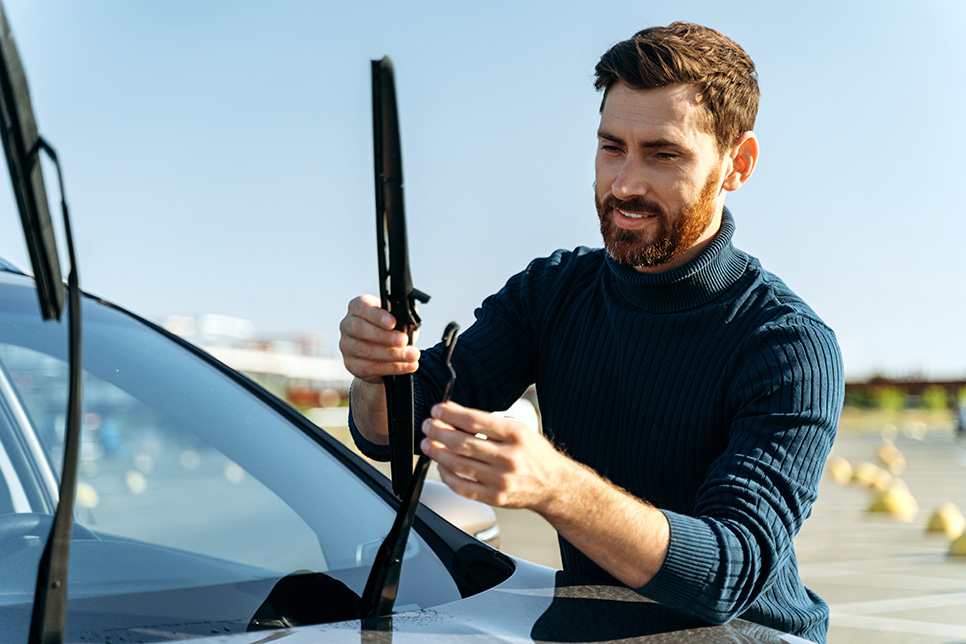Your windshield wipers are one of the most vital but overlooked safety components on your vehicle. Properly functioning wipers keep your view clear in hazardous weather year-round here in Colorado. But wipers wear out over time and need vigilant maintenance and replacement.
This comprehensive guide will equip Denver drivers with everything needed to optimize windshield wiper safety, performance, and longevity.
The Critical Role of Windshield Wipers
It’s easy to take windshield wipers for granted—until that first thick snowfall or torrential downpour when visibility instantly deteriorates. Your wipers serve the crucial function of clearing water, snow, grime, and debris off the windshield to maintain a reliably clear field of vision in all sorts of inclement conditions.
Consider this: windshield wipers are one of your front line defenses while driving. Along with headlights and brake lights, they work continuously to keep you safe especially at higher speeds. Damaged or worn out blades cannot properly clear precipitation buildup, severely hindering visibility and putting you and others at tremendous risk. Windshield wiper malfunction could also prevent you from seeing road hazards clearly enough to react safely.
The stakes are high when it comes to the operational effectiveness of your windshield wipers. Keep reading to learn all the essentials of keeping them in flawless shape through vigilant maintenance, timely replacement, and smart upgrades.
Keeping Your Wipers Safe
Worn or defective windshield wipers pose a frighteningly high accident risk in hazardous weather driving. As the rubber wiper edges deteriorate over months of use, they cannot form the consistent solid contact needed to fully clear water. Instead they begin streaking across the windshield glass, leave scattered tracks of rain residue, and generally fail at keeping your view unobstructed.
This critically diminished visibility makes it exponentially harder to spot and react to road hazards in time. You may not clearly see that sudden debris on the freeway soon enough to avoid it. Or notice the pedestrian about to step into traffic through the visual distortion caused by malfunctioning wipers scraping across the glass. Driving in rainy conditions with compromised wiper function slows driver reaction time. And winter snow conditions allowing wiper skipping or streaking can be even more hazardous.
How to Inspect Your Wipers
That’s why it’s so important to inspect your wipers regularly and replace them at the very first sign of deterioration. Every 1-2 months, give the wiper blades a visual check for:
- Cracks, nicks, gouges, or splits in the rubber especially near the edges.
- Flattened sections that cannot contour the windshield properly.
- Sticky opaque buildup that grabs and drags across the glass.
- Hardened, slick, shiny spots indicating the rubber has glazed over from chemical damage.
Also activate the wipers intermittently to check for:
- Streaking that leaves scattered water droplets behind.
- Chattering and skipping across the windshield indicating loss of solid contact.
- Squeaking noises signaling lack of lubrication.
- Juddering motions hinting at looseness or imbalance.
Any of these signs mean it’s replacement time right away. Wiper blades affected by winter conditions may need changing even more frequently as snow, scrapes, and de-icer chemicals accelerate wear.
Choosing Wiper Blades for Weather Conditions
If you face heavy snow and ice often, invest in winter blades boasting graphite or water-repelling coatings to resist snow and ice buildup. Make sure any cold weather wipers fit the distinct contour and measurements of your windshield model.
Summer thunderstorm and monsoon season calls for an excellent set of all-weather hybrid blades that can handle both torrential, wind-driven rains and the resulting hot dry conditions equally well.
And remember—always carefully scrape off ice from the entire windshield before ever turning wipers on. The slightest frozen edge catching will tear into the rubber and destroy the blade almost immediately.
Rubber vs Silicone Wiper Blades
Although traditional rubber wiper blades remain the most common type for durability and affordability, silicone versions have emerged as an interesting alternative. Here’s how they compare:
- Rubber blades withstand wear and tear well but are prone to cracking, splitting, and smearing over time which degrades performance. UV rays also break down the compounds quickly.
- Silicone blades cost 3-4 times more but far outlast rubber, often up to 3 years thanks to their stronger ozone/sunlight and chemical resistance.
- Silicone provides much smoother wavering on the glass with no juddering or chattering, and maintains its flexibility even in extreme cold down to -50F.
- However, rubber adapts better to a windshield’s complex contours and generally conforms to curves more flushly throughout its life for best contact.
- Grit, dirt and ice do not build up as easily on water-repellent silicone though galvanized treated rubber also sheds snow well.
Drivers experiencing frequent wiper failures despite regular care may want to consider splurging for long-lasting silicone units that maximize performance year round. Otherwise quality graphite-coated rubber blades keep most vehicles and climates covered at a lower cost.
Keeping Your Wipers in Peak Condition
Besides frequent replacement before damage sets in, you can extend your existing windshield wipers’ lifespan through consistent TLC. Here are the key maintenance best practices:
Clean the Blades and Windshield Regularly
Road grime, tree sap, bird droppings, and other stuck-on gunk disrupt the smooth glide the wiper edges rely on. About once a month, give the wiper blades and windshield glass a thorough cleaning with glass cleaner, rubbing alcohol to remove oily residue, soapy water if needed, and a microfiber cloth. Pay extra attention to the critical lower rubber edges that do the actual wiping work—any contamination buildup there interferes with proper water clearance.
Lubricate Linkages and Pivots
The metal joints, links, bracket connections, and pivot points that allow wiper arms to distribute smooth articulated force across the windshield also need regular lubrication. Every 3-4 months, apply a silicone lubricant spray specifically made for auto applications to these components. This prevents rust, sticky friction, and potential breakage over time.
Check and Refill Washer Fluid
At least monthly, verify your windshield washer reservoir levels stay topped off with fresh fluid. Allowing it to run dry renders the sprayers useless—a dangerous situation in precipitation. Refill it more frequently if you use the system often.
And remember to switch washer fluid types seasonally! Use winter de-icing formulas once ambient temps may drop below freezing to handle ice and snow. The right fluid prevents troublesome buildup and keeps your sightlines crystal clear.
Store Properly When Not In Use
Avoid leaving wiper arms lifted away from the glass off-seasons. Always return them to rest flat against the lower windshield when parked to maintain their intended shape and tension. This also shields the rubber edges from excessive sunlight and ozone damage. Consider using a windshield shade too for further protection.
Watch for Wear Indicators
As components age even with regular care, be vigilant about signs like hardened, cracked rubber, streaking, judder motions, loosening, and squeaking. These all indicate replacement time is coming up soon even if an item is not completely defunct yet. Being proactive saves you from getting caught off guard by sudden wiper failure during a blinding blizzard or microburst!
Staying vigilant with these basic maintenance practices ensures your wipers always clear away rain, snow, and grime effectively for maximum driving safety through all seasons.
Upgrading Your Windshield Wipers
When it does come time to replace your windshield wipers, consider upgrading to premium blades instead of settling for low-cost versions that seem like a good deal but wear out quicker. The extra investment is well worth it for dramatically better visibility and safety in inclement weather over the long run.
Beam & Hybrid Blade Upgrades
The very best windshield wiper models today typically feature an aerodynamic “beam” design with integrated spoilers to provide superior wiping performance. These contour precisely to the shape of modern curved windshields for full, consistent edge contact across the entire swipe path. This avoids skipped spots and streaks by maintaining a perfectly flush fit.
Other excellent options are hybrid blades combining the latest technologies like graphite-coated, jitter-free rubber edges, robust double-rail frames to resist warping, and enclosed tension springs preventing corrosion. Top hybrid models outperform old-school convention blades in every metric—smoothness, noise level, spray dispersion, and longevity.
Upgraded beam or hybrid wiper blades may carry a steeper upfront cost by $5-15 per blade, but many motorists find they outlast basic replacements 2-3x over before needing a swap. This makes their per-month value exceptional. And when driving safety is at stake, effective wipers capable of handling extreme snow and rainfall are well worth investing in.
Winter Wiper Upgrades
For regions with long, frigid, snowy winters, upgrading to cold-optimized winter blades prevents the all-too-common nightmare of frozen, ice-crusted wipers failing to clear your windshield. Seeking out graphite or water-repelling coated blades specifically engineered to withstand heavy frozen precipitation accumulation lets you drive securely regardless of conditions.
Pairing these premium wipers with an electric windshield heating system also works wonders. The embedded heating filaments in the glass itself prevent ice build-up across the surface that could otherwise overwhelm wipers. Kits featuring electric heating elements in washer fluid lines thaw frozen spray nozzles too.
Rain Sensing & Speed Control Upgrades
Today’s higher end vehicles now offer wiper systems with adjustable speed settings and even automatic rain-sensing capabilities. Splurging on these upgrades takes convenience and efficiency to the next level.
Rain sensor modules use infrared beams to detect precipitation density and determine appropriate wiping speed accordingly from a gentle intermittent dab to a furious back-and-forth flurry during downpours. No more fumbling awkwardly for the right manual setting every time conditions change.
And multi-speed dial or lever systems allow minute adjustments to wipe speed as desired. Crank it up a notch to handle snow flurries then dial back for a light mist. Take back control from the elements by custom tailoring wiper speed to the inclement situation at hand.
Component Upgrades
Finally, upgrading ancillary windshield wiper components like motors, transmissions and linkage joints also goes a long way towards keeping blades working at peak smoothness and efficiency even in demandingly harsh conditions.
Consider replacing creaky old wiper motors with heavy duty units boasting higher torque, variable speeds, and weatherproof stainless steel construction. Repair or replace any linkages with excessive play or stiffness that throw off symmetry. And ensure wiper transmission gears engage cleanly for flawless back-and-forth articulation cycle after cycle without grating or catching.
Taking this integrated approach to windshield wiper upgrades provides the reliability and visibility peace of mind all drivers desire during Colorado’s tumultuous weather shifts.
In Summary
Caring meticulously for your windshield wipers and glass surfaces translates directly into driving visibility and safety for you and all sharing Colorado roads. Maintain your wiper blades in prime condition through monthly inspections, cleaning regimens, lubricating pivots, checking washer fluid levels and more. Always replace blades at the very first indication of wear before damage sets in.
When buying replacements, consider premium beam, hybrid or winter blade upgrades offering graphite water resistance coatings and aerodynamic shapes conforming perfectly across the windshield. Adding electric heating elements, rain sensor modules, and variable speed settings create the ultimate convenience and performance combination.
Stay proactive and your windshield wipers will provide you with clear Colorado driving for many miles ahead!


